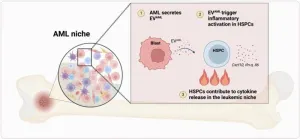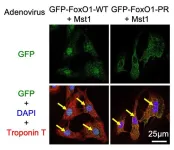(Press-News.org) A study published in Eurosurveillance to investigate an outbreak of Shiga toxin-producing Escherichia coli (STEC) O157:H7 in the UK identified contaminated lettuce as the most likely source of the infection, and determined that heavy rainfall and flooding may have carried STEC from animal faeces to the lettuce crops. More heavy rainfall events are expected due to climate change in the future, leading to increased impacts on health and food security.
Ahead of Field Epidemiology Day 2024, this study demonstrates the value of field investigations in quickly responding to outbreaks, improving preparedness, and protecting public health, and possible novel methods for field epidemiology in the future.
It also demonstrated the value of new integrative techniques with a One Health approach, using weather data and information on animal and land use data to better understand the events and conditions that may have led to the STEC infection outbreak.
Outbreak detection and cases
After a large outbreak of STEC 0157:H7 was detected in the UK in September 2022, a national-level investigation was initiated to identify the source of the outbreak and inform risk mitigation strategies. Whole genome sequencing (WGS) was used to identify outbreak cases, and strongly suggested a link to a single source.
There were 259 cases and 7 secondary cases linked to the outbreak, with symptom onset reported from 5 August to 12 October 2022. 75 cases were admitted to hospital, with no deaths being reported.
Epidemiological, food chain and environmental investigations
All confirmed cases were requested to complete a questionnaire to provide information on demographics, clinical symptoms, environmental and food exposures, which was then analysed. Hypothesis generation interviews were then undertaken with 19 cases to determine the source of exposure, with the most frequently reported exposures being eating out, eating chicken, exposure through salad leaves or prepacked salad, and beef.
A frequency-matched case-control study was undertaken across the UK with 41 cases and 206 controls. Multivariable and univariable analysis of each exposure variable was carried out, linking illness to consumption of chicken and salad items, both of which became the focus of early food chain investigations.
The only product with significant links identified between product type, purchase location and supply chain was lettuce, which became the main focus of investigation. Loyalty card data and supply chain investigations found that a single lettuce grower, Grower X, was directly or indirectly linked to all food service establishments and/or retailers of interest in this outbreak.
The harvesting period for Grower X had ended in October 2022, and competent authorities visited Grower X after the harvest had ended. All requirements had been met and no failures were identified.
Geospatial analysis of meteorological, flood risk, land use and sheep population data independently identified Grower X as the likely source of the outbreak.
Epidemiological, food chain and meteorological analysis then allowed researchers to establish a timeline of events and a cascading risk pathway for the outbreak, which determined that STEC present in contaminated faeces from sheep may have been carried to lettuce crops through heavy rainfall.
Public health implications
The novel, integrative methods for this outbreak investigation showcase the benefits of approaching public health from the perspective of One Health, which takes into account the health of people, safe food production, animals, and environment, and could help predict, prevent and tackle potential outbreaks.
As floods and heavy rainfall are expected to increase with climate change, this approach could also improve understanding of the impact of climate change on public health, and inform climate adaptation efforts in the future.
END
Study on E. coli outbreak in the UK demonstrates increasing impact of climate change on public health and food security
A study to investigate an UK E. coli outbreak identified contaminated lettuce as the most likely source of the infection, and determined that heavy rainfall and flooding may have carried STEC from animal feces to the lettuce crops
2024-09-05
ELSE PRESS RELEASES FROM THIS DATE:
Using 3D imaging to transform plastic waste recycling
2024-09-05
In a global first, University of Waterloo researchers have used 3D imaging technology to understand the fine details of microplastics, paving the way for more effective methods of plastic waste recycling.
Micro and nanoplastics, tiny particles of plastic that come from the breakdown of larger plastic items, have become an exponentially worsening environmental crisis. Due to their difficulties in safely decomposing, plastic pollution poses significant threats to ecosystems, wildlife and human health.
Scientists have struggled to understand the exact process of ...
Case for inflammatory memory for hematopoietic stem and progenitor cells in AML niche
2024-09-05
“In this research perspective, we discuss recent work from our lab describing an active role of HSPCs in AML and the potential implications.”
BUFFALO, NY- September 5, 2024 – A new research perspective was published in Oncotarget's Volume 15 on September 4, 2024, entitled, “Trained and ready - the case for an inflammatory memory for hematopoietic stem and progenitor cells in the AML niche.”
As noted in the abstract of this paper, lifelong hematopoiesis is sustained by the crosstalk between hematopoietic stem and progenitor cells (HSPCs) and specialized bone marrow ...
For many animals sleep is a social activity, but it’s usually studied as an individual process
2024-09-05
Group sleeping can impact when animals sleep, how long they sleep for, and how deeply they sleep. For example, groups of meerkats time their sleep according to “sleep traditions”; olive baboons sleep less when their group size increases; bumblebees suppress sleep in the presence of offspring; and co-sleeping mice can experience synchronized REM sleep. To fully understand both sleep and animal social structures, we need to pay more attention to the “social side” of sleep, animal behaviorists argue in an opinion paper publishing September 5 in the Cell Press journal ...
Human brain cancers fire electrical impulses – researchers reveal unexpected hybrid cell spiking the signals
2024-09-05
Researchers at Baylor College of Medicine and the Jan and Dan Duncan Neurological Research Institute at Texas Children’s Hospital have uncovered a new cell type in the human brain.
The study published in Cancer Cell reveals that a third of the cells in glioma, a type of brain tumor, fire electrical impulses. Interestingly, the impulses, also called action potentials, originate from tumor cells that are part neuron and part glia, supporting the groundbreaking idea that neurons are not the only cells that can generate electric signals in the brain. The scientists also discovered ...
Pancreatic cancer: study finds most early staging inaccurate
2024-09-05
Staging of patients with early pancreatic cancer is inaccurate as much as 80% of the time, according to a new Cedars-Sinai Cancer study published in the peer-reviewed journal JAMA. The finding underscores the urgent need for advancements in diagnostic technology and staging, which could significantly alter early pancreatic cancer treatment and research.
In this study, investigators looked at data from more than 48,000 patients in the National Cancer Database. Based on preoperative imaging, all of the patients in the study had either stage 1 or stage 2 pancreatic cancer.
Following surgery to remove their tumors, more than 78% of stage ...
Study shows fentanyl’s role in Oregon overdose spike after policy decriminalizing drug possession
2024-09-05
PROVIDENCE, R.I. [Brown University] — When overdose rates spiked in Oregon in 2021 after the state decriminalized low-level drug possession, blame quickly turned to the new state law. But a new study by researchers at the Brown University School of Public Health implicates another factor: the introduction of fentanyl into Oregon’s unregulated drug market.
“What's compelling about this analysis is that it follows the path of fentanyl across the country and offers testament to the ...
Vision impairment and the population attributable fraction of dementia in older adults
2024-09-05
About The Study: The population attributable fraction of dementia from vision impairments ranged from 4.9%-19.0%. While not proving a cause-and-effect relationship, these findings support inclusion of multiple objective measures of vision impairments, including contrast sensitivity and visual acuity, to capture the total potential impact of addressing vision impairment on dementia.
Corresponding Author: To contact the corresponding author, Jason R. Smith, ScM, email jsmit491@jhu.edu.
To access the embargoed study: Visit our For The Media website at this link https://media.jamanetwork.com/
(doi:10.1001/jamaophthalmol.2024.3131)
Editor’s ...
Balloon angioplasty vs medical management for intracranial artery stenosis
2024-09-05
About The Study: In patients with symptomatic intracranial atherosclerotic stenosis, balloon angioplasty plus aggressive medical management, compared with aggressive medical management alone, statistically significantly lowered the risk of a composite outcome of any stroke or death within 30 days or an ischemic stroke or revascularization of the qualifying artery after 30 days through 12 months. The findings suggest that balloon angioplasty plus aggressive medical management may be an effective treatment for symptomatic intracranial atherosclerotic stenosis, although the risk of stroke or ...
Cannabis laws and utilization of medications for the treatment of mental health disorders
2024-09-05
About The Study: This cross-sectional study of commercially insured patients suggests that there may have been meaningful heterogeneous associations between cannabis policy and state and between cannabis policy and drug class (e.g., decreases in dispensing of benzodiazepines but increases in dispensing of antidepressants and antipsychotics). This finding suggests additional clinical research is needed to understand the association between cannabis use and mental health. The results have implications for patient substance use and mental health–related outcomes.
Corresponding Author: To ...
New avenues for treating heart failure: uncovering a protective mechanism in the cardiac myocytes
2024-09-05
Researchers from Tokyo Medical and Dental University (TMDU) identify Mst1–FoxO1–C/EBP-ß signaling pathway that promotes heart cell survival
Tokyo, Japan – Understanding the mechanisms behind cell death and survival is crucial when it comes to conditions like heart failure, which affects millions of people worldwide. Now, researchers from Japan have identified a mechanism which protects cardiac myocytes against ischemia, or a lack of blood supply.
In this study published online on 25 July 2024 in Nature Communications, researchers from the Tokyo Medical and Dental ...
LAST 30 PRESS RELEASES:
Numbers in our sights affect how we perceive space
SIMJ announces global collaborative book project in commemoration of its 75th anniversary
Air pollution exposure and birth weight
Obstructive sleep apnea risk and mental health conditions among older adults
How talking slows eye movements behind the wheel
The Ceramic Society of Japan’s Oxoate Ceramics Research Association launches new international book project
Heart-brain connection: international study reveals the role of the vagus nerve in keeping the heart young
Researchers identify Rb1 as a predictive biomarker for a new therapeutic strategy in some breast cancers
Survey reveals ethical gaps slowing AI adoption in pediatric surgery
Stimulant ADHD medications work differently than thought
AI overestimates how smart people are, according to HSE economists
HSE researchers create genome-wide map of quadruplexes
Scientists boost cell "powerhouses" to burn more calories
Automatic label checking: The missing step in making reliable medical AI
Low daily alcohol intake linked to 50% heightened mouth cancer risk in India
American Meteorological Society announces Rick Spinrad as 2026 President-Elect
Biomass-based carbon capture spotlighted in newly released global climate webinar recording
Illuminating invisible nano pollutants: advanced bioimaging tracks the full journey of emerging nanoscale contaminants in living systems
How does age affect recovery from spinal cord injury?
Novel AI tool offers prognosis for patients with head and neck cancer
Fathers’ microplastic exposure tied to their children’s metabolic problems
Research validates laboratory model for studying high-grade serous ovarian cancer
SIR 2026 delivers transformative breakthroughs in minimally invasive medicine to improve patient care
Stem Cell Reports most downloaded papers of 2025 highlight the breadth and impact of stem cell research
Oxford-led study estimates NHS spends around 3% of its primary and secondary care budget on the health impacts of heat and cold in England
A researcher’s long quest leads to a smart composite breakthrough
Urban wild bees act as “microbial sensors” of city health.
New study finds where you live affects recovery after a hip fracture
Forecasting the impact of fully automated vehicle adoption on US road traffic injuries
Alcohol-related hospitalizations from 2016 to 2022
[Press-News.org] Study on E. coli outbreak in the UK demonstrates increasing impact of climate change on public health and food securityA study to investigate an UK E. coli outbreak identified contaminated lettuce as the most likely source of the infection, and determined that heavy rainfall and flooding may have carried STEC from animal feces to the lettuce crops





